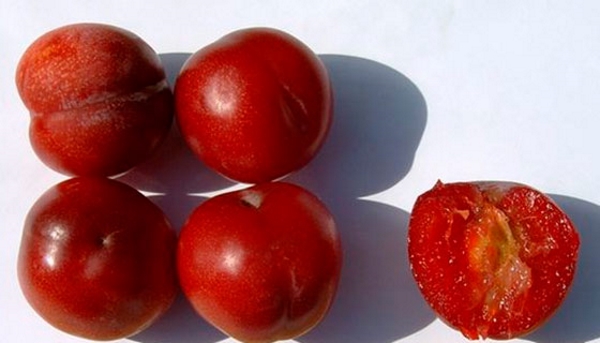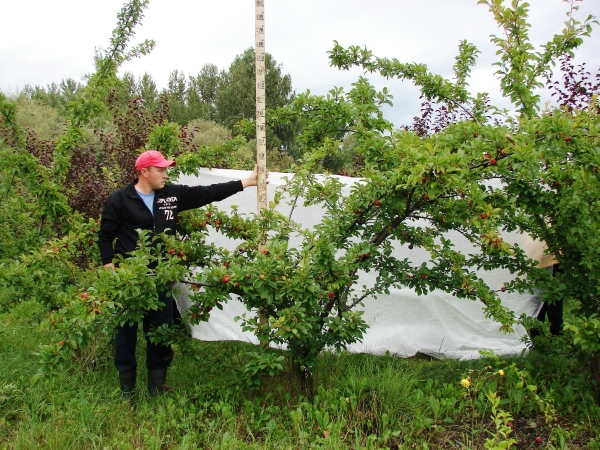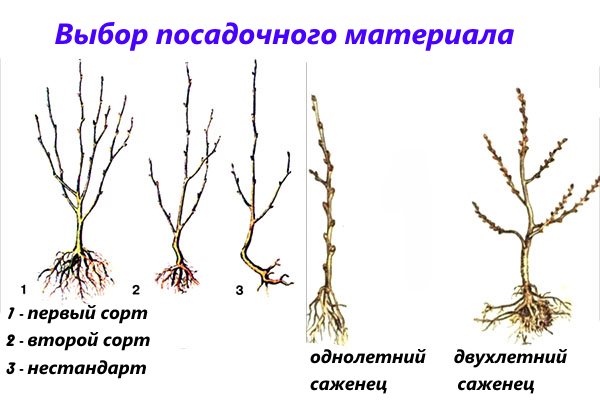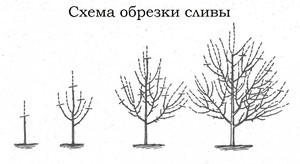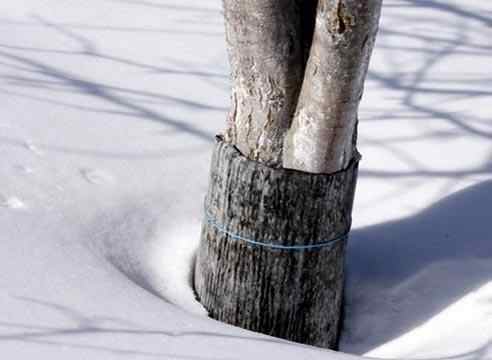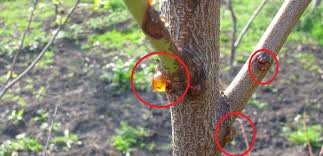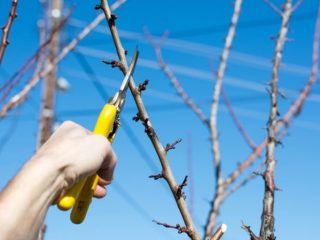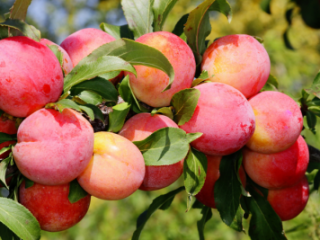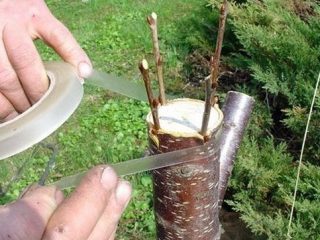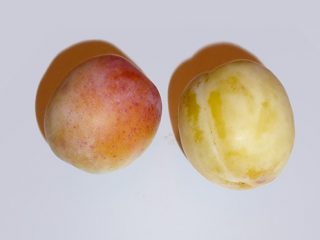Content
Krasnomyasaya plum is one of the most favorite plum varieties among gardeners. It grows both in the southern and northern regions: in the Urals, in Siberia. High adaptability and survival rate in almost any conditions have made this variety the most widespread in any region of the country.
History of variety selection
The plum variety Krasnomyasaya was obtained at the Lisavenko Research Institute of Plants and Plants in Altai (Chemal) by crossing Chinese plum and cherry plum. The Red Myasaya plum has many subspecies, such as Oval, Bolshaya, Podgornaya and others. All 12 types of this plum are frost-resistant and have high yields.
Description of the Krasnomyasaya plum
- The tree is not very tall, reaching 4 m, but garden farms grow representatives of this species with a height of 3–3.5 meters.
- The bark is smooth, light gray. Red meat plum has a compact, sparse, spherical crown.It is good to place low-growing plants in the openwork shade of a tree.
- The leaves of Krasnomyasaya are dark green in color and jagged. The leaf blade is fleshy, light green underneath. The surface is smooth, glossy.
- The flowers are small, pale pink, with regular oval petals, their usual number is 5.
- The fruits are dark red, fleshy, juicy, have a sweet and sour taste with a pronounced plum aroma. The shape of the berries is round, sometimes slightly elongated. The skin is sour and may taste bitter. The stone is small, oval, and easily separated from the pulp. The weight of the fetus ranges from 20 g to 30 g.
- The Krasnomyasaya plum has an average fruit ripening period. Harvest occurs in mid-August. From one tree you can collect up to 20 kg of berries. They tolerate transportation well and do not deteriorate.
The variety is grown everywhere in the southern and northern regions, since the red meat plum is frost-resistant and drought-resistant.
Characteristics of the variety
The Krasnomyasaya plum has all the main characteristics of its relatives, but there are still some features of the variety.
Drought resistance, frost resistance
Red myasaya plum is a drought-resistant variety that does not tolerate the proximity of groundwater, exposure to wind and drafts.
It is characterized by high frost resistance. Tolerates winter well. This explains its spread in the northern regions.
Pollinators of the Red myasa plum
The Krasnomyasaya variety is self-sterile and therefore requires planting pollinators in the neighborhood. Often the Ussuri plum is chosen for this; hybrid cherry plum is also suitable. It pollinates well with Skoroplodnaya and Russian plums. The flowering period of these species occurs at the beginning of May; the presented varieties bloom synchronously, so there are no problems with pollination.Fruit ripening occurs in the second half of August.
Productivity and fruiting
Fruiting of the Krasnomyasaya plum variety occurs in the middle - end of August, depending on the region. In the southern part of Russia, plums begin to ripen in early August, in the northern regions - in the last days of summer.
Red meat plum is characterized by high yield. From one tree you can collect up to 20 kg of fruit. The variety bears fruit annually, regardless of weather conditions.
Area of application of berries
Krasnomyasaya plum fruits are used both fresh and processed. Dried fruits, juice, jam, and baked goods are prepared from them. Housewives make preparations for the winter from plum fruits.
Resistance to diseases and pests
Red Myasaya plum is a variety that is resistant to most pests and diseases characteristic of plums. Not affected by aphids, but susceptible to gum development. It resists well to the main enemy of plums - clasterosporiosis.
Advantages and disadvantages of the variety
Advantages of Krasnomyasaya:
- high productivity;
- good taste of fruits;
- frost resistance and drought resistance;
- resistance to most diseases inherent in plums;
- high adaptability to climatic conditions;
- annual fruiting.
Disadvantages of plum:
- self-sterility (requires pollinators);
- loves good lighting;
- does not tolerate drafts;
- needs non-acidified soils where there is no groundwater.
This variety has more advantages than disadvantages. This is the reason for the widespread distribution of plums in Europe and Asia.
Landing Features
Red meat does not differ in most planting conditions from its relatives.But plums are picky about the planting site and the choice of neighbors.
Recommended timing
The tree is planted in the spring, after frost, in soil already warmed by the sun. Depending on the region, this may be the end of March - the beginning of May.
Planting is possible in the fall, before frost sets in, when the soil is still warm enough and night temperatures do not drop below zero.
Choosing a suitable location
Red meat grows on any soil except acidified soil. Requires a well-lit place.
It is advisable to place the seedling in the south or eastern part of the site. Choose a sunny place for the plant, excluding the windy side. It is good to plant a tree under the cover of a building, fence, or other trees.
Planting plum:
What crops can and cannot be planted nearby?
Red meat plum gets along with many garden crops. The only thing that cannot be planted nearby are tall trees. Red-fleshed does not tolerate darkening.
Since this variety is self-sterile, it is good to plant the seedling surrounded by cherry plum and any type of Russian plum, keeping a distance of 10 meters.
Selection and preparation of planting material
It is better to purchase a seedling for planting at a nursery in order to obtain a beautiful cultivated plant. Select specimens with a well-developed root system and an even, strong trunk, sufficiently thick and durable.
Having chosen a plant, you need to wrap the root in cloth or oilcloth to retain moisture until planting. Before planting, the tree should be removed to a dark, cool place.
Landing algorithm
- For the future tree, dig a hole 50–70 cm deep, depending on the length of the roots.
- The entire root must fit in the hole with the exception of the root collar - it must remain on the surface.
- A wooden peg about a meter long must be driven into the middle of the hole: it will serve as a support for the seedling.
- A seedling is lowered into the middle of the hole and tied lightly to a peg with soft twine or ribbon so as not to damage the plant trunk.
- The root system is covered with loose soil and carefully trampled down.
- Then the seedling must be watered abundantly.
Aftercare for plums
Red meat plum does not require complex care, but pruning, watering and preparation for winter are necessary for the plant.
- Pruning of the plant is carried out in the fall, after harvesting, in the spring, before the sap begins to flow, or in the summer, as necessary. Remove old dry branches, thin out the crown, trying to bring its shape closer to spherical. To do this, cut off long parts of old branches, promoting the formation of young shoots.
- In the fall, after harvesting, the plum needs to be watered generously 2-3 times.
- It is good to combine moisturizing with fertilizing. You can dilute humus or nitrogenous fertilizers in a watering bucket according to the instructions.
- In anticipation of frost, it is good to wrap the tree trunk with branches of spruce plants or shrubs. The top of the garden insulation is wrapped in cellophane, roofing felt or fabric. This will protect the tree from frost and rodents.
You can learn how to prepare plums for winter from the video:
Diseases and pests, methods of control and prevention
Red meat is not susceptible to diseases characteristic of plums. But there is a disease that is inherent in this variety - gum disease. Gum is a thick, resin-like substance that comes from lesions on a tree trunk.
The following steps can be taken to prevent and treat this disease:
- Do not injure the tree by removing old dead bark to a deep layer.
- Grow varieties according to their survival rate in certain climatic conditions: frost or sun can damage the integrity of the bark.
- Whiten tree trunks 2 times a year - in spring and autumn. This will protect the plum from the rays of the scorching sun.
- Wrap the plum tree for the winter, protecting the trunk from frost and rodents.
- Perform pruning with special tools (do not break branches), do it on time, without waiting for old branches to break off.
For treatment, the gum is cleaned with a garden knife, disinfected with copper sulfate, and the wound is covered with garden pitch.
Conclusion
Red myasaya plum is one of the most unpretentious varieties of this species. The tree's yield is high, and virtually no maintenance is needed. If the garden needs to be replenished with an undemanding but well-fruiting specimen, then this variety is ideal.

